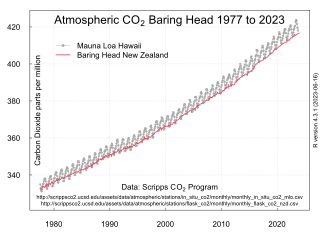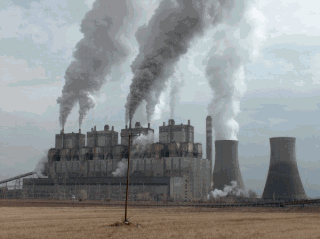A carbon credit is a generic term for any tradable certificate or permit representing the right to emit one tonne of carbon dioxide or the equivalent amount of a different greenhouse gas (tCO2e).
An emission intensity is the emission rate of a given pollutant relative to the intensity of a specific activity, or an industrial production process; for example grams of carbon dioxide released per megajoule of energy produced, or the ratio of greenhouse gas emissions produced to gross domestic product (GDP). Emission intensities are used to derive estimates of air pollutant or greenhouse gas emissions based on the amount of fuel combusted, the number of animals in animal husbandry, on industrial production levels, distances traveled or similar activity data. Emission intensities may also be used to compare the environmental impact of different fuels or activities. In some case the related terms emission factor and carbon intensity are used interchangeably. The jargon used can be different, for different fields/industrial sectors; normally the term "carbon" excludes other pollutants, such as particulate emissions. One commonly used figure is carbon intensity per kilowatt-hour (CIPK), which is used to compare emissions from different sources of electrical power.

A carbon footprint is historically defined as the total emissions caused by an individual, event, organization, or product, expressed as carbon dioxide equivalent. Greenhouse gases (GHGs), including carbon dioxide, can be emitted through land clearance and the production and consumption of food, fuels, manufactured goods, materials, wood, roads, buildings, transportation and other services.

Ensuring adequate energy supply to sustain economic growth has been a core concern of the Chinese government since 1949. Primary energy use in China was 26,250 TWh and 20 TWh per million persons in 2009. According to the International Energy Agency, the primary energy use grew 40% and electricity use 70% from 2004 to 2009.

Canada was active in the negotiations that led to the Kyoto Protocol in 1997, and the Liberal government that signed the accord in 1997 also ratified it in parliament in 2002. Canada's Kyoto target was a 6% total reduction by 2012 compared to 1990 levels of 461 Megatonnes (Mt). However, in spite of some efforts, federal indecision led to increases in greenhouse gas emissions (GHG) since then. Between the base year (1990) and 2008 Canada's GHG increased by around 24.1%.
Human activities — including the burning of fossil fuels, deforestation, agricultural practices, industrial processes, refrigeration, and the use of several consumer products — result in the emission of greenhouse gases.

The Thailand Greenhouse Gas Management Organisation (TGO) is an autonomous governmental organization under the Ministry of Natural Resources and Environment (MNRE) established by the royal decree, Establishment of Thailand Greenhouse Gas Management Organisation BE 2550 (2007). It is responsible for reducing greenhouse gas (GHG) emissions in Thailand. The royal decree came into force as of 7 July 2007.

Climate change in New Zealand refers to change in the climate of New Zealand on the scale of years, decades, centuries and longer periods of time. New Zealand is being affected by climate change and the impacts are predicted to increase in future. Anthropogenic global warming during the 20th century is apparent in the instrumental temperature record, in New Zealand's participation in international treaties, and in social and political debates.
The Chinese national carbon trading scheme is a cap and trade system for carbon dioxide emissions set to be implemented by the end of 2017. This emission trading scheme (ETS) creates a carbon market where emitters can buy and sell emission credits. From this scheme, China can limit emissions, but allow economic freedom for emitters to reduce emissions or purchase emission allowances from other emitters. China is currently the largest emitter of greenhouse gases and many major Chinese cities have severe air pollution. With this plan, China will soon be the largest market in carbon trading. The scheme will limit emissions from six of China’s top carbon dioxide emitting industries, including coal-fired power plants. China was able to gain experience in drafting and implementation of an ETS plan from the United Nations Framework Convention on Climate Change (UNFCCC), where China was part of the Clean Development Mechanism (CDM). From this experience with carbon markets, and lengthy discussions with the next largest carbon market, the European Union (EU), as well as analysis of small scale pilot markets in major Chinese cities and provinces, China’s national ETS will be the largest of its kind and will help China achieve its Intended Nationally Determined Contribution (INDC) from the Paris Agreement in 2016.

Energy in Belgium describes energy and electricity production, consumption and import in Belgium.
The European plan on climate change consists of a range of measures adopted by the members of the European Union to fight against climate change. The plan was launched in March 2007, and after months of tough negotiations between the member countries, it was adopted by the European Parliament on December 2008. The package focuses on emissions cuts, renewables and energy efficiency.
This article is about the Kyoto Protocol and government action in relation to that treaty.
Measurement of life-cycle greenhouse gas emissions involves calculating the global-warming potential of electrical energy sources through life-cycle assessment of each energy source. The findings are presented in units of global warming potential per unit of electrical energy generated by that source. The scale uses the global warming potential unit, the carbon dioxide equivalent, and the unit of electrical energy, the kilowatt hour (kWh). The goal of such assessments is to cover the full life of the source, from material and fuel mining through construction to operation and waste management.
The United States Environmental Protection Agency (EPA) began regulating greenhouse gases (GHGs) under the Clean Air Act from mobile and stationary sources of air pollution for the first time on January 2, 2011. Standards for mobile sources have been established pursuant to Section 202 of the CAA, and GHGs from stationary sources are currently controlled under the authority of Part C of Title I of the Act. The basis for regulations was upheld in the United States Court of Appeals for the District of Columbia in June 2012.
Global warming in Luxembourg discuss the global warming issues in Luxembourg.
Reid Gardner Generating Station was a 557 megawatt coal fired plant on 480 acres (190 ha) located near Moapa, Nevada. It was co-owned by NV Energy (69%) and California Department of Water Resources (31%). The plant consisted of four units. The first three were 100 MW units and were placed into service in 1965, 1968 and 1976. The fourth unit placed into service in 1983 produced 257 megawatts (345,000 hp). Three units of Reid Gardner were shut down in 2014; the fourth went in March 2017.

The long tailpipe is an argument stating that usage of electric vehicles does not always result in fewer emissions compared to those from non-electric vehicles. While the argument acknowledges that plug-in electric vehicles operating in all-electric mode have no greenhouse gas emissions from the onboard source of power, it claims that these emissions are shifted from the vehicle tailpipe to the location of the electrical generation plants. From the point of view of a well-to-wheel assessment, the extent of the actual carbon footprint depends on the fuel and technology used for electricity generation.

Turkey emits about 500 megatonnes (Mt) of greenhouse gases (CO2eq) each year, about 6 tons per person, and has no plans for a peak in emissions. The country was one of those contributing most to growth in global emissions in the decade to 2018. Although Turkey is likely to meet its unambitious Intended Nationally Determined Contribution its policies as of 2018 would still result in 2030 emissions being half as much again or even double 2010 emissions; which is why its plans to limit emissions have been described as "critically insufficient". Climate change in Turkey is forecast to accelerate.
Climate change in Indonesia is of particular significance, because its enormous coastal population is particularly at risk to sea level rise and because the livelihoods of so many of its people depend on agriculture, mariculture and fishing, all of which could be severely impacted by temperature, rainfall and other climactic changes.












